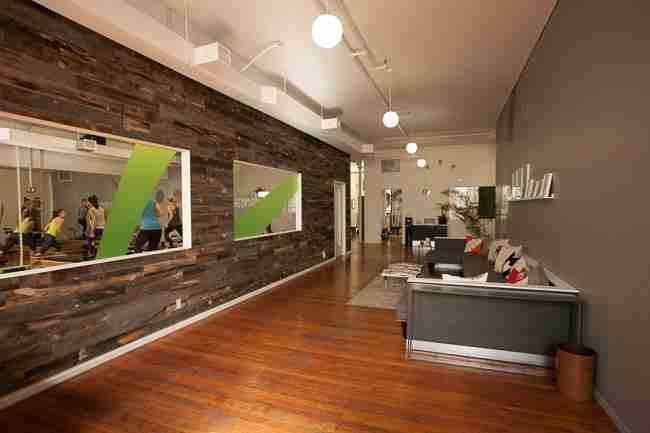By JOSEPH PISANI
AP Business Writer
NEW YORK (AP) _ Slim one-room gyms are in, and the low cost of starting them is turning gym rats and workout instructors into entrepreneurs.
There are no Olympic-sized pools, rows of treadmills or steam rooms in these small fitness studios. Instead, devotees sweat through hour-long classes in tiny spaces, swinging heavy kettlebells or practicing yoga poses. Some of the studios resemble high-energy nightclubs with dim lights and loud music. Classes can be pricy, at about $30 each, but that’s not keeping people away.
Boutique fitness studios are growing fast, popping up in cities around the country, taking over small spaces that once housed businesses such as beauty salons or video game shops. Starting out small makes these slim gyms a low-risk bet for aspiring entrepreneurs.
“We started this with zero dollars,” says Brittany Blum, co-owner of yoga studio Ritual San Francisco. Ritual opened earlier this year in a 1,000-square-foot studio that is inside a large gym. Ritual’s owners negotiated a deal with the gym, paying it a percentage of sales instead of a monthly rent.
Ritual charges $25 for its classes. Yoga moves are set to the beat of bass-heavy songs, such as Ginuwine’s “Pony” and 50 Cent’s “Candy Shop.” The studio is lit only with candlelight, and clients get a head massage before leaving. “You feel like a better version of yourself; calmer, happier, more energized,” says Anne Faricy, a brand strategist in San Francisco, who goes to Ritual’s classes about four times a week.
Blum is looking for a second space for Ritual that’s double the size. The current studio holds 16 customers at a time. “It’s packed in there,” Blum says.
Two years ago, The Fhitting Room in New York opened with a 1,000-square foot studio; now there are two additional locations in the city.
The “hit” in Fhitting’s spelling stands for high intensity training, a strength-building workout that uses kettlebells and pull-up bars. Owner Kari Saitowitz was a marketing executive before she quit to raise her two children. She started taking high intensity training classes and decided to open a studio of her own. Saitowitz hires trainers to teach the $35 classes, while she focuses on the studio’s branding. The lime green towels, for example, match the color of The Fhitting Room’s logo, customers are called “Fhixers” and t-shirts sold at the studios say “Live Fhit.”
Saitowitz plans to open a studio outside of New York. “We have a short list of cities,” she says.
Boutique fitness studios are the fastest growing part of the gym industry, says Meredith Poppler, spokeswoman for the International Health, Racquet and Sportsclub Association. They made up 21 percent of the fitness industry in 2013, the first and most recent year the IHRSA measured boutique studios. Awareness may grow even more next month, when the E! network airs “Hollywood Cycle,” a reality show that follows the owners and instructors of Los Angeles cycling studio Cycle House.
The trend has been fueled, in part, by cycling chain SoulCycle and intense workout craze CrossFit, says Poppler, both of which gained popularity in the past decade. And word of mouth helps too: “If you’re seeing results,” Poppler says, “you’re going to tell your friends about it.”
Fitness fanatics are willing to pay for the high-priced classes because they “see being fit as a status symbol,” says health club consultant Bryan O’Rourke. “There’s a cool factor.”
O’Rourke says studios can be opened for as little as $30,000, if the space is small and not much equipment is needed, but can balloon to $500,000 if owners go all out with designing the interior. By comparison, hiring staff, buying exercise equipment and building locker rooms for a big, traditional gym can cost up to $1 million or more. Major cities, such as New York, Los Angeles and Miami, face fierce competition from already established studios, O’Rourke says.
Garrett Roberts planned to open a 14,000-square-foot gym in Hoboken, New Jersey, but negotiations on the $30,000 a month rent fell through and a big gym chain snapped up the space. A real estate agent showed him a nearby 1,000-square-foot studio for $2,050 a month in 2011. He took it. “It wasn’t a huge investment,” Roberts says. He opened GoRow, a studio with nine rowing machines that charges $29 a class. Many of GoRow’s customers live in Hoboken, but work in New York, where they’re used to walking past boutique fitness studios. “I knew it would work,” he says.
At Grit Fitness in Dallas, classes can sell out a week in advance, says owner Brittani Rettig. She opened the studio in January, using $30,000 she saved up before quitting a consulting job late last year. She plans to open a second location this fall.
Grit Fitness packs up to 25 people in its 1,100 square-foot studio, charging $25 a person for kickboxing classes or hip-hop dance lessons. The crowded room keeps people pumped up, Rettig says, “Do you want to go a bar or restaurant with four people in it? No, you want to go to a crowded place with energy.”
When class starts, the overhead lights are turned off, the colorful flashing lights go on and the music is turned up. “Nothing serene, chill or calm,” says Rettig. “There’s a lot of Beyoncé going on.













No Comment